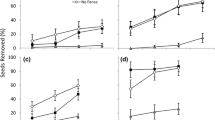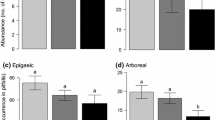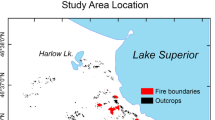Abstract
Myrmecochory (seed dispersal by ants) is a prominent dispersal mechanism in many environments, and can play a key role in local vegetation dynamics. Here we investigate its interaction with another key process in vegetation dynamics—fire. We examine ant dispersal of seeds immediately before and after experimental burning in an Australian tropical savanna, one of the world’s most fire-prone ecosystems. Specifically, our study addressed the effects of burning on: (1) the composition of ants removing seeds, (2) number of seed removals, and (3) distance of seed dispersal. Fire led to higher rates of seed removal post-fire when compared with unburnt habitat, and markedly altered dispersal distance, with mean dispersal distance increasing more than twofold (from 1.6 to 3.8 m), and many distance dispersal events greater than the pre-fire maximum (7.55 m) being recorded. These changes were due primarily to longer foraging ranges of species of Iridomyrmex, most likely in response to the simplification of their foraging landscape. The significance of enhanced seed-removal rates and distance dispersal for seedling establishment is unclear because the benefits to plants in having their seeds dispersed by ants in northern Australia are poorly known. However, an enhanced removal rate would enhance any benefit of reduced predation by rodents. Similarly, the broader range of dispersal distances would appear to benefit plants in terms of reduced parent–offspring conflict and sibling competition, and the location of favourable seedling microsites. Given the high frequency of fire in Australian tropical savannas, enhanced benefits of seed dispersal by ants would apply for much of the year.




Similar content being viewed by others
References
Andersen AN (1982) Seed removal by ants in the mallee of northwestern Victoria. In: Buckley RC (eds) Ant-plant interactions in Australia. Junk, The Hague, pp 31–44
Andersen AN (1988a) Dispersal distance as a benefit of myrmecochory. Oecologia 75:507–511
Andersen AN (1988b) Immediate and longer-term effects of fire on seed predation by ants in sclerophyllous vegetation in south-eastern Australia. Aust J Ecol 13:285–293
Andersen AN (1991) Responses of ground foraging ant communities to three experimental fire regimes in a savanna forest of tropical Australia. Biotropica 23:575–585
Andersen AN (2003) Ant biodiversity in arid Australia: productivity, species richness and community organisation. Rec South Aust Mus Monogr Ser 7:79–92
Andersen AN, Morrison SC (1998) Myrmecochory in Australia’s seasonal tropics: effects of disturbance on distance dispersal. Aust J Ecol 23:483–491
Andersen AN, Cook GD, Williams RJ (eds) (2003) Fire in tropical savannas: the Kapalga experiment. Springer, Berlin Heidelberg New York
Antonovics J, Clay K, Schmitt J (1987) The measurement of small-scale environmental heterogeneity using clonal transplants of Anthoxanthum odoratum and Danthonia spicata. Oecologia 71:601–607
Auld TD, Denham AJ (1999) The role of ants and mammals in dispersal and post-dispersal seed predation of the shrubs Grevillea (Proteaceae). Plant Ecol 144:201–213
Beattie AJ (1983) Distribution of ant-dispersed plants. Sonderbd Naturwiss Ver Hamb 7:249–270
Beattie AJ (1985) The evolutionary ecology of ant–plant mutualisms. Cambridge University Press, Cambridge
Beattie AJ, Culver DC (1981) The guild of myrmecochores in the herbaceous flora of West Virginia forests. Ecology 62:107–115
Berg RY (1975) Myrmecochorous plants in Australia and their dispersal by ants. Aust J Bot 23:475–508
Bestelmeyer BT, Wiens JA (2003) Scavenging ant foraging behaviour and variation in the scale of nutrient redistribution among semi-arid grasslands. J Arid Environ 53:373–386
Bond W, Slingsby P (1984) Collapse of an ant-plant mutualism: the Argentine ant (Iridomyrmex humilis) and myrmecochorous Proteaceae. Ecology 65:1031–1037
Bond WJ, Stock WD (1989) The costs of leaving home: ants disperse myrmecochorous seeds to low nutrient sites. Oecologia 81:412–417
Bond WJ, van Wilgen BW (1996) Fire and plants. Chapman & Hall, London
Boyd RS (2001) Ecological benefits of myrmecochory for the endangered chaparral shrub Fremontodendron decumbens (Sterculiaceae). Am J Bot 88:234–241
Bradstock RA, Williams JE, Gill AM (eds) (2002) Flammable Australia: the fire regimes and biodiversity of a continent. Cambridge University Press, Cambridge
Brennan K (1996) Flowering and fruiting phinology of native plants in the Alligator Rivers Region with particular reference to the Ranger uranium mine. Supervising scientist report 107, Commonwealth of Australia
Brock J (1988) Top End Native Plants. Brock, Darwin
Christian CE (2001) Consequences of biological invasion reveal importance of mutualism for plant communities. Nature 413:635–639
Christian CE, Stanton ML (2004) Cryptic consequences of a dispersal mutualism: seed burial, elaiosome removal, and seed-bank dynamics. Ecology 85:1101–1110
Cowling RM (1992) Ecology of fynbos: nutrients, fire and diversity. Oxford University Press, Oxford
Crist TO, Wiens JA (1994) Scale effects of vegetation on forager movement and seed harvesting by ants. Oikos 69:37–46
Culver DC, Beattie AJ (1978) Myrmecochory in Viola: dynamics of seed-ant interactions in some West Virginia species. J Ecol 66:53–72
Davidson DW, Morton SR (1981) Myrmecochory in some plants (f. Chenopodiaceae) of the Australian arid zone. Oecologia 50:357–366
Farji-Brener AG, Corley JC, Bettinelli J (2002) The effects of fire on ant communities in north-western Patagonia: the importance of habitat structure and regional context. Divers Distrib 8:235–243
Fewell JH (1988) Energetic and time costs of foraging in harvester ants, Pogonomyrmex occidentalis. Behav Ecol Sociobiol 22:401–408
Flora of Australia (2001) Mimosaceae, Acacia, part 2, vol 11B. ABRS/CSIRO, Melbourne
Giladi I (2006) Choosing benefits or partners: a review of the evidence for the evolution of myrmecochory. Oikos 112:481–492
Gómez C, Espadaler X (1998) Myrmecochorous dispersal distances: a world survey. J Biogeogr 25:573–580
Gómez C, Espadaler X, Bas JM (2005) Ant behaviour and seed morphology: a missing link of myrmecochory. Oecologia 146:244–246
Hoffmann BD (2003) Responses of ant communities to experimental fire regimes on rangelands in the Victoria River District of the Northern Territory. Aust Ecol 28:182–195
Hughes L, Westoby M (1992) Fate of seeds adapted for dispersal by ants in Australian sclerophyll vegetation. Ecology 73:1285–1299
Kaspari M, Weiser MD (1999) The size-grain hypothesis and interspecific scaling in ants. Funct Ecol 13:530–538
Keith DA, McCaw WL, Whelan RJ (2002) Fire regimes in Australian heathlands and their effects of plants and animals. In: Bradstock RA, Williams JE, Gill AM (eds) Flammable Australia: the fire regimes and biodiversity of a continent. Cambridge University Press, Cambridge, pp 199–280
Majer JD (1980) The influence of ants on broadcast and naturally spread seeds in rehabilitated bauxite mined areas. Reclam Rev 3:3–9
McGlynn TP, Shotell MD, Kelly MS (2003) Responding to a variable environment: home range, foraging behaviour and nest relocation in the Costa Rican rainforest ant Aphaenogaster araneoides. J Insect Behav 16:687–701
Nielsen MG (2001) Energetic costs of foraging in the ant Rhytidoponera aurata in tropical Australia. Physiol Entomol 26:248–253
Ness JH (2004) Forest edges and fire ants alter the seed shadow of an ant-dispersed plant. Oecologia 138:448–454
Ness JH, Bronstein JL, Andersen AN, Holland JN (2004) Ant body size predicts dispersal distance of ant-adapted seeds: implications of small-ant invasions. Ecology 85:1244–1250
Ness JH, Bressmer K (2005) Abiotic influences on the behaviour of rodents, ants and plants affect an ant–seed mutualism. Ecoscience 12:76–81
O’Dowd DJ, Hay ME (1980) Mutualism between harvester ants and a desert ephemeral: seed escape from rodents. Ecology 61:531–540
Parr CL, Robertson HG, Biggs HC, Chown SL (2004) Response of African savanna ants to long-term fire regimes. J Appl Ecol 41:630–642
Russell-Smith J, Ryan PG, Klessa D, Waight G, Harwood R (1998) Fire regimes, fire-sensitive vegetation and fire management of the sandstone Arnhem Plateau, monsoonal northern Australia. J Appl Ecol 35:829–846
Sanders NJ, Gordon DM (2002) Resources and the flexible allocation of work in the desert ant, Aphaenogaster cockerelli. Insect Soc 49:371–379
Usnick SJ (2000) Foraging distance of Pogonomyrmex occidentalis (Hymenoptera: Formicidae) on grazed and ungrazed shortgrass prairies in Colorado. Entomol News 111:201–205
Westoby M, Rice BL, Shelley JM, Haig D, Kohen JL (1982) Plants’ use of ants for dispersal at West Head, New South Wales. In: Buckley RC (eds) Ant–plant interactions in Australia. Junk, The Hague, pp 75–87
Whitney KD (2002) Dispersal for distance? Acacia ligulata seeds and meat ants Iridomyrmex viridiaeneus. Aust Ecol 27:589–595
Willliams RJ, Gill AM, Moore PHR (1998) Seasonal changes in fire behaviour in a tropical savanna in Northern Australia. Int J Wildland Fire 8:227–239
Williams RJ, Gill AM, Moore PHR (2003) Fire behavior. In: Andersen AN, Cook GD, Williams RJ (eds) Fire in tropical savannas: the Kapalga experiment. Springer, Berlin Heidelberg New York, pp 33–46
York A (1999) Long-term effects of frequent low-intensity burning on the abundance of litter-dwelling invertebrates in coastal blackbutt forests of southeastern Australia. J Insect Conserv 3:191–199
Acknowledgements
We thank Rob Dunn and two anonymous reviewers for their useful comments on earlier versions of this manuscript. Funding was provided through the Bushfire Cooperative Research Centre.
Author information
Authors and Affiliations
Corresponding author
Additional information
Communicated by Peter Clarke.
Rights and permissions
About this article
Cite this article
Parr, C.L., Andersen, A.N., Chastagnol, C. et al. Savanna fires increase rates and distances of seed dispersal by ants. Oecologia 151, 33–41 (2007). https://doi.org/10.1007/s00442-006-0570-5
Received:
Accepted:
Published:
Issue Date:
DOI: https://doi.org/10.1007/s00442-006-0570-5




